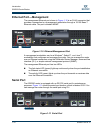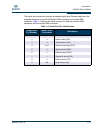
Planning
iSCSI Performance
SN0051103-00 A 2-3
A
Distance
Consider the physical distance between Fibre Channel devices. Choose SFP
transceivers that are compatible with the cable type and distance.
Each Fibre Channel port is supported by a data buffer with a three-credit capacity;
that is, three maximum sized frames. For fibre optic cables, this enables full
bandwidth over the following approximate distances:
5 kilometers at 1 Gbps (0.6 credits/Km)
2.5 kilometers at 2 Gbps (1.2 credits/Km)
Beyond these distances, however, the connection loses some efficiency because
the transmitting port must wait for an acknowledgement before sending the next
frame.
Bandwidth
Bandwidth is a measure of the volume of data that can be transmitted at a given
transmission rate. A 1-Gbps/2-Gbps FC port can transmit or receive at nominal
rates of 1- or 2-Gbps, depending on the device to which it is connected. This
corresponds to actual bandwidth values of 106 MB and 212 MB, respectively.
Latency
Latency is a measure of how fast a transaction travels through the router.
iSCSI Performance
The iSR6250 router supports Ethernet service at transmission rates of 1000-, 100-
or 10-Mbps with an MTU size of 1500 or 9000 (jumbo frames).
Related performance characteristics include the following:
Distance
Bandwidth
Latency
Distance
Consider the physical distance between routers.This is usually measured in
round-trip delay. Round-trip delays range anywhere from less than 1 millisecond
to as great as 250 milliseconds.
NOTE:
An MTU size greater than 1500 should only be used when the router is
connected to a 1000 Mbps Ethernet network.


















